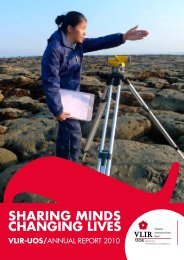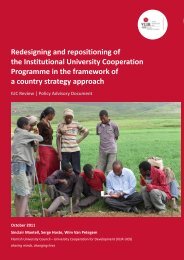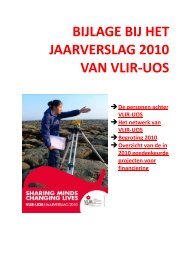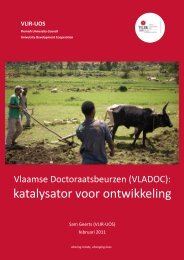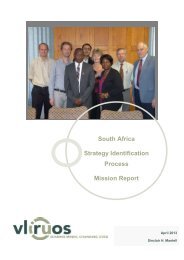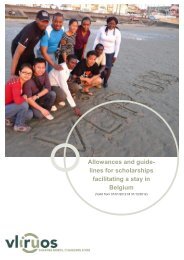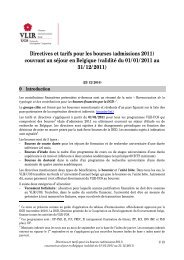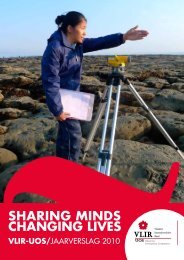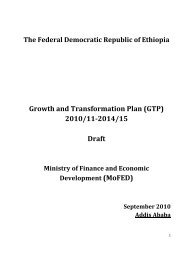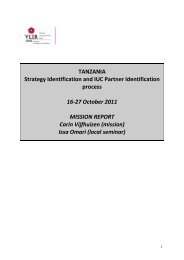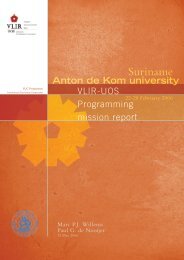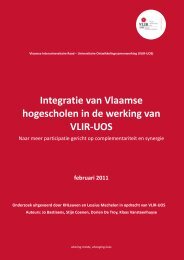Education Sector Development Program - VLIR-UOS
Education Sector Development Program - VLIR-UOS
Education Sector Development Program - VLIR-UOS
Create successful ePaper yourself
Turn your PDF publications into a flip-book with our unique Google optimized e-Paper software.
<strong>Education</strong> <strong>Sector</strong> <strong>Development</strong> <strong>Program</strong> IV<br />
The capacity<br />
development program<br />
will aim at improving<br />
management at federal<br />
and at decentralized<br />
levels and within<br />
higher education<br />
institutions.<br />
3. Policy and strategies<br />
The capacity development program will aim<br />
at improving management at federal and<br />
at decentralized levels and within higher<br />
education institutions. It will do so through a<br />
three-pronged approach.<br />
Firstly, the existing skills and competencies of<br />
individual officers will be upgraded through<br />
systematic professional development<br />
programs. These will go beyond the one-off<br />
training courses and will integrate a varied<br />
set of workshops, courses and other trainingrelated<br />
events together with the provision of<br />
support and guidance materials. This part<br />
of the program will be closely linked to the<br />
management and administration program /<br />
MAP component of GEQIP. One focus will be<br />
on strengthening EMIS. Moreover, developing<br />
and linking a school mapping data base, using a<br />
GIS (geographic information system) with EMIS<br />
for educational planning is an area that can be<br />
strengthened. The capacity development in EMIS<br />
may need to address this important component<br />
(GIS and EMIS at federal, regional and woreda<br />
level).<br />
4. <strong>Program</strong> matrix<br />
A second part of the program will look at<br />
organizational functioning and aims at<br />
developing clarity around the mandate of the<br />
various organizations and at their internal<br />
structure and their relationships. This will<br />
strengthen collaboration between the different<br />
levels and help create a proactive administration.<br />
Special efforts will be undertaken to ensure<br />
greater communication between the policy level<br />
and the technical level within the educational<br />
organizations.<br />
Thirdly, for an organization to be effective, it<br />
does not only need an appropriate structure.<br />
It also needs a minimum level of human and<br />
financial resources. Under ESDP IV, standards<br />
on the minimum numbers and profile of staff in<br />
all organizations and on the minimum level of<br />
resources to be available to all organizations will<br />
be developed and information will be collected in<br />
this regard.<br />
Throughout this capacity development program,<br />
specific attention will be given to the following<br />
areas: educational planning and management<br />
and the collection and use of information for<br />
decision-making.<br />
Strategies and component activities Indicator/target *<br />
Component 1: More effective planning,<br />
management, resource allocation and utilization<br />
through improving skills of educational experts<br />
Designing appropriate professional development<br />
programs for experts from Federal Ministry, REBs<br />
and Woreda offices in collaboration with these<br />
experts, with special focus on emerging regions.<br />
And on needs of women professionals<br />
Organizing professional development programs in<br />
educational planning and management<br />
Organizing professional development programs in<br />
EMIS<br />
Developing and making available guidelines and<br />
support materials in educational planning and<br />
management and in EMIS<br />
Developing and making available guidelines and<br />
support materials in school mapping and GIS<br />
All leaders and experts will have the expected<br />
skills to undertake their work competently<br />
Professional development programs exist for<br />
experts from Federal Ministry, REBs and Woreda<br />
offices<br />
Professional development programs give specific<br />
attention to women professionals<br />
All educational planning and management experts<br />
have participated in at least one professional<br />
development program<br />
All EMIS experts have participated in at least one<br />
professional development program<br />
No of guidelines and support materials developed<br />
% of experts with access to these materials<br />
No of guidelines and support materials developed<br />
% of experts with access to these materials<br />
* See comment on indicators and/or targets at the beginning of chapter 3.<br />
70



